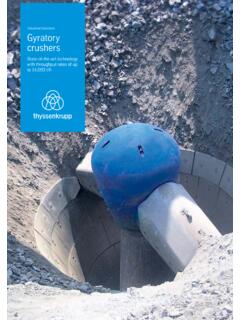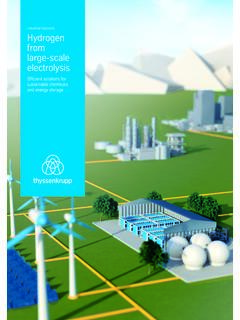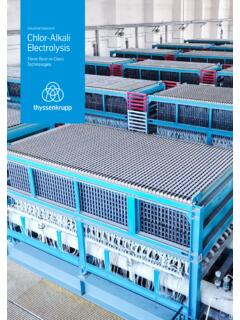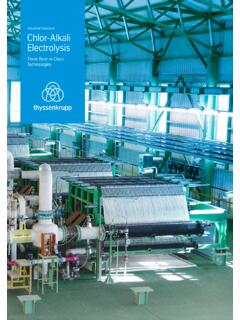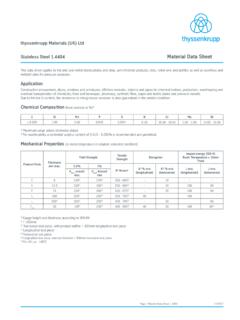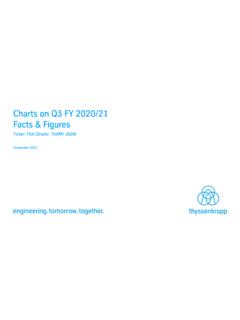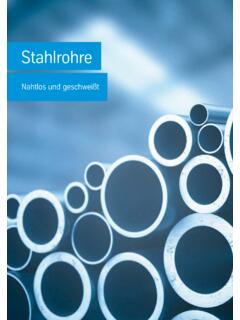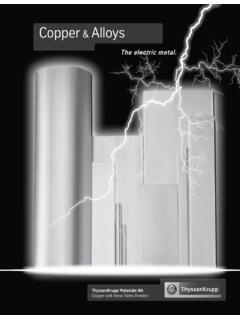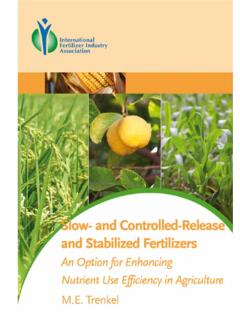Transcription of Industrial Solutions Ammonia technology - ThyssenKrupp
1 Industrial SolutionsAmmonia technologyBoost your business with our leading fertilizer 13:03 Cutting-edge technology since 1928 The first Ammonia plant to use an uhde proprietary process went on stream at a German coalmine site way back in 1928. Ammonia plant in fertilizer complex in Tecen, Turkmenistan Capacities: 600 mtpd of Ammonia 1,050 mtpd of urea synthesis 1,050 mtpd granulation unitAround 90 years of turnkey EPC Solutions tailored to our customers 13:03 FeedstocksProductsUreagranulesDEFDe-NOX FluidUreaprillsUANANN itrogen fertilizerPhosphate and compound fertilizerDAPNP(K)ASCANE nergy(natural gas, naphtha, coal, biomass, hydrogen)LimestoneSulfurPhosphate rockPotassiumASgranulationSulfuricacid plantPhosphoric acid plantAS solutionDAP/MAPgranulationSulfurdispersi ng plantASplantUrea plantUrea prillingAmmonia plantUreagranulationMelamineplantUreaESU rea-ESgranulationNitric acidplantANplantUANplantAN/CANgranulatio nSynthesis gas generationBeneficiationGypsum = ThyssenKrupp processes = Third-party processesNP(K)
2 GranulationThe first plant built in 1928 had an Ammonia output of 100 metric tons per day (mtpd). These first uhde -engineered Ammonia reac-tors featured a remarkably efficient technology with an internal heat exchanger and a synthesis loop with an integrated two-stage refrigeration unit. uhde never lost its focus on energy efficiency, as evidenced by the design of a plant with an energy consumption of only Gcal/mt of Ammonia as early as 1968. Nowadays we are ready to design down to Gcal/mt of Ammonia . To improve plant efficiency even further, the focus has been on reducing power consumption, improving process heat recovery, minimizing stack losses, and cutting energy consumption for CO2 removal.
3 With around nine decades of experience and broadly based expertise we are continuing to make improvements in energy efficiency, plant operability and reliability possible. More recent milestones in Ammonia technology were achieved at plants we built in Al Jubail, Saudi Arabia, and Louisiana, USA, both fea-turing a single-train capacity in excess of 3,300 mtpd: In 1928 the first Ammonia plant started production for the Mont-Cenis Mine in Herne, Industrial Solutions offers you the complete process chain for the production of different fertilizers:This brochure tells you more about the state-of-the-art Ammonia plant technology we offer to customers worldwide and, in particu-lar, what benefits it will bring to plant technology 13.
4 03 The process gas leaving the primary reformer enters the second-ary reformer at the bottom. The gas is routed through the central internal riser pipe into the combustion chamber at the top of the secondary reformer. Process air is introduced into this combustion chamber via nozzles, arranged around the circumference of the combustion chamber. The partially oxidized gas passes from top to bottom through the catalyst bed, which is supported by a ceramic arch. Finally, the gas leaves the secondary reformer at the bottom. The process gas from the secondary reformer has to be cooled from 1,000 C to a controlled temperature suitable for the down-stream CO shift.
5 The sensible heat can best be utilized in the gen-eration and superheating of high-pressure steam. The challenge in designing suitable cooling train equipment is to arrive at a concept that provides safe temperature limitation for all parts according to their particular load sensitivity and materials of construction. In addition, the equipment has to be available at competitive prices. For five decades we have both used and promoted the use of the horizontal fire-tube boiler and a high-pressure steam good process on its own is not enough. Reliable designs for critical items of equipment are just as important.
6 Only a combination of the two will make a good plant. At ThyssenKrupp Industrial Solutions we have pioneered the development of essential items of equipment for Ammonia plants: Such innovative developments have made us one of the leading technology providers in this field. We hold a number of patents for such equipment and have granted numerous manufacturing and marketing licenses to equipment manufacturers and chemical engineering reformer and process gas cooling trainThe uhde primary reformer is a furnace in which tubes filled with catalyst are heated by burners located in the furnace ceiling.
7 The process gas temperature required at the outlet of the catalyst-filled tubes is about 800 C at a pressure of approx. 45 bar. Inevitably, the service life of components such as the reformer tubes is limited. Reformer tubes regularly exceed their expected lifetime. The gas leaving the tubes is routed through a refractory-lined cold outlet manifold system to a secondary primary reformeruhde secondary reformerCooling train equipmentPioneers in critical plant equipment Primary reformer with a cold outlet manifold system Secondary reformer Process gas cooling train downstream of the secondary reformer for generating and superheating high-pressure steam High-efficiency Ammonia converter system with up to three beds, indirect heat exchange and radial flow Ammonia synthesis waste heat boiler4 13.
8 03 Secondary reformerWater jacketCombustion zoneProcess airRefractoryCatalystProcess gasArchProcess gas from primary reformerPrimary reformerReformer tubesCold outletmanifold systemBurnersInlet manifoldProcess gas to secondary reformerInnovative developments have made us one of the leading technology providers in this uhde designs 13:036 High conversion rates and large catalyst volume Maximum utilization of reaction heat for generation of high-pressure steam Low pressure drop in the loopThe demand for energy-efficient Ammonia production dictates the design of the Ammonia synthesis unit so that it can deliver the fol-lowing beneficial features: To fulfill these demands, the uhde Ammonia synthesis design incorporates three radial-type catalyst beds arranged in either one or two Ammonia converters.
9 At ThyssenKrupp Industrial Solutions we look back on a long tradi-tion of designing high-pressure synthesis loop boilers, having pio-neered this type of equipment in Ammonia converter and waste heat recoveryThe uhde Ammonia synthesis design incorporates three radial-type catalyst beds arranged in either one or two Ammonia Ammonia converterAmmonia converter I, catalyst beds 1 and 2 Ammonia converter II,catalyst bed 3 Start-up gasStart-up gasSecond bedGas outletGas outletGas outletSecond bedThird bedThird bedFirst bedFirst bedBypass controlGas inletGas inletGas 13:03 Ammonia plant in Ma aden, Saudi ArabiaCapacity:3,300 mtpd of ammoniaHP steam boiler with integrated BFW preheaterGas outletBFW inletContinuous blow downBFW bypassIntermittent blow downVane separatorSteam outletGas inletProprietary uhde designs 13:03uhde dual-pressure process The key innovation of the uhde dual-pressure process is an addi-tional medium-pressure, once-through Ammonia synthesis con-nected in series with the conventional high-pressure Ammonia synthesis loop.
10 The first plant to apply this process was the SAFCO IV Ammonia plant in Al-Jubail, Saudi Arabia, with a capacity of 3,300 mtpd, which started up in 2004. Since then, three more plants based on the uhde dual-pressure process have come on stream with similar capacities. Ma'aden 1 & 2 in Saudi Arabia and CFI Donaldsonville in USA are all exceeding their design many years, the capacities of chemical plants have been grow-ing significantly to lower specific production costs through econo-mies of scale. More than ever before, the plant construction sector is now being challenged to exploit this advantage while continuing to employ proven technologies and equipment.
